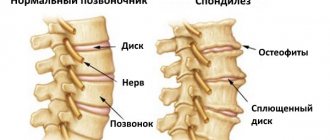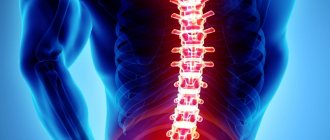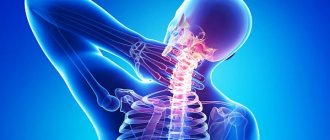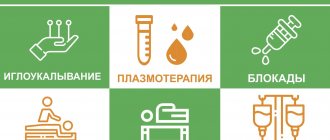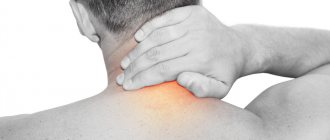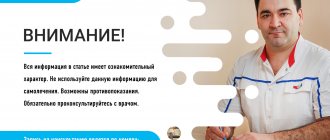Causes of lumbodynia
Chronic lower back pain (lumbodynia) is most often caused by degenerative-dystrophic changes in the lumbar spine. This is osteochondrosis of the spine and its manifestations and consequences such as protrusion, intervertebral disc herniation, spondyloarthrosis (arthrosis of the facet joints of the vertebrae), and deforming spondylosis. If it is known that the cause of pain is changes in the intervertebral disc (herniation or protrusion), then the wording “Discogenic lumbodynia” can be used.
Diagnosis of lumbodynia
Lumbodynia can be diagnosed in different ways. A neurologist diagnoses this disease. The most common is a clinical examination and questioning of the patient, combined with static and dynamic examination of the spine, as well as manual diagnostics. Additionally, the organs of the pelvic and abdominal cavities are examined to exclude diseases that are a source of referred pain. In addition, MRI, radiography, and ultrasound diagnostics will not be superfluous. During the examination, lumbodynia is differentiated from myositis of the spinal muscles and pathologies of the hip joint.
IMPORTANT! Lumbodynia is a serious symptom that can tell a person about significant problems in the lumbar spine, ranging from inflammatory phenomena to destructive diseases. That is why, if you have lumbodynia, you cannot self-medicate, but you should definitely consult a specialist!
Experienced doctors at the Kuntsevo Medical and Rehabilitation Center will conduct a thorough diagnosis and understand the causes of the symptom. A treatment plan for the patient will then be drawn up. Make an appointment with our doctor and take a step towards getting rid of lumbodynia!
Sign up
Lumbodynia - the first signs of osteochondrosis
Lumbodynia syndrome (low back pain) is often the first clinical sign of osteochondrosis of the lumbar spine. Lumbar osteochondrosis in almost half of the cases at the beginning of its course manifests itself as subacute or chronic lumbodynia.
What causes lumbodynia
Lower back pain can occur after a single severe physical fatigue, lower back injury, hypothermia, or stress. In some cases, days, weeks or even months pass before pain appears after these actions.
At first, very mild lumbodynia may appear. Some patients note that their pain developed slowly and for no apparent reason. But this does not mean at all that there was no provoking factor. It’s just that this factor is not always obvious.
Then the lower back pain may intensify. Most often this happens gradually. But the pain usually does not reach the same degree of severity as lumbar pain - lumbago (acute lumbodynia). Patients walk independently and do certain work, although it is difficult for them to bend, but even more difficult for them to straighten up. At the same time, they often place their hand on the lower back, rubbing or massaging it a little. And only after that they can straighten up. Such people try to sit with a straight back.
Chronic pain in the lower back (CLBP, chronic lumbodynia) in 80-90% of cases is caused by so-called nonspecific causes (nonspecific CLBP - CNBP) - muscle tension, dysfunction of the facet, costotransverse or sacroiliac joints, tension of the ligaments [1— 5]; much less often - radiculopathy (4-15%) or a specific cause (neoplasm, foci of infection, compression fractures) [2, 3, 6].
Therapy for CNBP is aimed at reducing the intensity of pain and improving the quality of life of patients, which is reduced due to pain, limitation of activity, decreased performance and deterioration of mood, and incorrect behavior patterns. The most effective is a multidisciplinary approach, which includes the rationalization of drug therapy, a complex of therapeutic exercises, correction (if necessary) of the workplace, as well as cognitive behavioral therapy (CBT) [1, 2, 6].
Rational pharmacotherapy of patients with CNLD includes the prescription of non-steroidal anti-inflammatory drugs (NSAIDs) during exacerbation, antidepressants, muscle relaxants, as well as therapy for concomitant diseases that may contribute to the deterioration of the condition [4, 7, 8].
Therapeutic gymnastics plays a leading role in the treatment of CNLF [2, 6, 9]. It has significant advantages compared to physiotherapeutic treatment, manual therapy, and imitation of therapeutic exercises. When it is carried out, a decrease in the intensity of pain and the duration of disability, as well as an improvement in the functional state of patients, are noted.
The use of CBT is based on the idea of the relationship between thoughts, feelings and behavioral stereotypes, which changes with competent systematic targeted treatment [10, 11].
CBT includes techniques aimed at identifying inadequate and maladaptive ideas and behavioral skills of the patient and replacing them with adequate and adaptive ones. In case of CNLD, the patient’s well-being and degree of disability are determined not only by muscular or other pathology, but also by psychological and social factors. The latter are represented by “maladaptive” (dysfunctional) thoughts (wrong views and beliefs regarding the nature and prognosis of the disease), concomitant psychological disorders (anxiety, depression, sleep disorders) and, as a result, “painful” behavior. With a significant increase in the duration of chronic pain syndrome, psychological factors are especially important, and pain goes beyond “just physical pain” and begins to affect other areas of a person’s life (family, work) [11, 12]. Currently, this is facilitated by the results of studies: computed tomography (CT), magnetic resonance imaging (MRI), radiography, which can be incorrectly assessed by patients and sometimes by doctors. Information about disc herniations detected by CT or MRI and suspected compression of the spinal nerves (even in the absence of corresponding clinical symptoms) can increase pain and disability in patients. It is widely believed that any physical activity in the presence of pain can lead to significant deterioration, as a result of which patients begin to limit physical activity, which leads to a deterioration in their general condition and contributes to the chronicity of the pain syndrome. The goal of CBT is to identify these “harmful” and “maladaptive” thoughts and, using arguments and examples, explain to the patient the causes and mechanisms of back pain, as well as the importance of maintaining physical and social activity and returning to work [11]. For concomitant emotional disorders (depression), CBT may come to the fore in treatment [11]. The inclusion of CBT in complex treatment significantly increases its effectiveness [8, 10, 11]. CBT is widely used in modern clinics in Europe, where it is part of the so-called multidisciplinary approach to the treatment of CLI [6].
At the Clinic of Nervous Diseases (CND) named after. AND I. Kozhevnikov, a comprehensive approach is used in patients with CNLF, including CBT. A positive effect is often achieved in cases where patients could not obtain the effect during repeated courses of outpatient and inpatient treatment.
We present two clinical observations.
Patient
, 54 years old, upon admission complained of aching pain in the lumbosacral region with an intensity of up to 7 points on the visual analogue scale (VAS), more on the left, spreading to the gluteal region, as well as the inability to walk for a long time (more than 150 steps) and stand (more than 15 min).
The life history should include work involving prolonged sitting and driving for at least 4 hours a day. He suffers from arterial hypertension (takes Noliprel) and has uterine fibroids. For the first time, the patient began to notice pain in the lumbar spine without radiating to the legs in 2008 due to heavy lifting combined with a stressful situation (she was caring for seriously ill relatives); conservative therapy was carried out with a moderate effect. In 2010, radiography revealed antelisthesis of the Lv vertebra (Fig. 1), and therefore an operation was performed: hemilaminectomy of the Lv vertebra on both sides, radiculolysis, stabilization at the level of the lower lumbar and SI vertebra (Fig. 2). After the operation, high-intensity “axial” pain developed, which made it difficult to move. Gradually, pain radiated into the left buttock and along the outer surface of the left leg to the ankle joint, which arose and intensified with static load and walking. In 2012, the patient was hospitalized for the first time at the KNB.
In somatic status, grade I obesity (body mass index 33.2 kg/m2). In the neurological status, attention is drawn to lumbar hyperlordosis, oblique pelvis, limited mobility in the lower lumbar spine due to stabilization, hypermobility in the upper lumbar spine, dysfunction of the sacroiliac joint on the left with the reproduction of a typical pattern of pain during palpation in its projection, piriformis syndrome on the left, moderate muscular-tonic syndrome of paravertebral muscles at the lumbar level on both sides. The average pain intensity according to VAS is 5 points, at the time of examination - 7 points. Oswestry disability scale - 46%. On the Beck Depression Inventory at the time of the first hospitalization - 13 points. On the hospital anxiety and depression scale at the time of the first hospitalization - 3 and 6 points, respectively. Laboratory studies revealed no significant deviations from the norm.
Clinical diagnosis: “chronic left-sided lumboischialgia: muscular-tonic syndrome of the paravertebral muscles at the lumbar level, piriformis syndrome on the left, dysfunction of the sacroiliac joint on the left. Comorbid diseases: stage I obesity, arterial hypertension.”
Treatment of the patient at the KNB in 2012 included fluoxetine 40 mg/day, sirdalud 12 mg/day, therapeutic and diagnostic blockades (with novocaine, dexamethasone/diprospan) in the projection of the sacroiliac joint and the piriformis muscle on the left, post-isometric relaxation of the piriformis muscle. After treatment, a positive effect was noted in the form of a decrease in pain, an increase in the time possible for standing and walking. After 1 year, the patient was readmitted to the KNB, and a similar course of treatment was carried out with the addition of CBT (three conversations during hospitalization and telephone counseling on emerging issues 2-3 times).
The patient had her own ideas about back pain, among which were both true (“therapeutic exercises and increased activity should help,” “the ability to self-care will not be affected,” “excessive activity and a sedentary lifestyle can worsen the condition”) and false (“the fastener compresses some nerve”, “displacement of the vertebrae causes pain”, “walking can worsen the condition”, “it is necessary to regularly repeat CT/MRI for control”).
The directions of cognitive therapy in this case included the formation of a correct understanding by the patient of the causes, mechanisms of the disease and the development of the pain syndrome: clarification of the absence of the fact of “compression of the nerve root” by any structures (absence of symptoms of prolapse), as well as a direct connection between the severity of pain and changes on MRI/CT , explanation of the true causes of pain: tension of the piriformis and paravertebral muscles, dysfunction of the sacroiliac joint.
Factors that contributed to the chronicity of back pain in this clinical situation were also identified: stress at the onset of the disease (the death of her husband and mother-in-law, whom she was caring for), excess body weight, “frightening” MRI results, doctors’ statements and the recommendation of “urgent” surgery, increased pain after surgery, incorrect pessimistic ideas about the mechanisms of pain.
Together with the patient, an action program was formed, which included daily therapeutic exercises with a gradual increase in load, performing exercises after static loads, a gradual slow increase in walking duration, weight loss (fluoxetine, diet, increased physical activity). Upon reaching the age of 55, the patient retired, which led to a significant decrease in static load and an increase in physical activity (swimming 2 times a week, daily walks and therapeutic exercises).
1 year after the complex treatment, there was a decrease in the average pain intensity according to VAS in the lumbar spine from 5 to 2 points, and a decrease in the Oswestry scale index from 46 to 28%. The patient’s own assessment of the effectiveness of treatment is 8-9 out of 10 possible points.
Patient,
76 years old, upon admission complained of pain in the lumbar and thoracic spine with an intensity of up to 10 points according to VAS, a feeling of “stiffness” in the spine, nagging pain along the anterior surface of the left shin from the level of the knee to the foot, pain in the projection of the left hip joint, numbness fingers and toes, a feeling of numbness in the right half of the chest, sleep disturbances due to intense back pain.
Somatic history is aggravated: bilateral coxarthrosis (aseptic necrosis of the femoral head on the left, endoprosthetics of the hip joint on the right in 2004), osteoporosis, for which he is not receiving therapy, gastric resection (1997) for peptic ulcer, exertional angina (II functional class), ventricular extrasystole, arterial hypertension. The patient was diagnosed with atherosclerosis of the aorta, cerebral and coronary arteries (stenosis of the internal carotid arteries up to 65-75%), moderate chronic iron deficiency anemia. Works as a librarian and loves to communicate with people. Due to the pain, social activity decreased significantly, sleep was disturbed, and the patient planned to end her working life.
For a long time, there was pain in the lumbosacral spine without radiation to the legs. On January 10, 2013, against the background of a single increase in temperature to 38.5°C (then the low-grade fever persisted for 1 week), intense pain in the thoracic spine and a feeling of shortness of breath appeared. Due to the pain syndrome, my appetite decreased and I lost 10 kg in 1 year. For a year, conservative treatment, including NSAIDs, analgesics, and therapeutic blockades, was without effect. In March 2014, the patient was hospitalized at the KNB.
Body mass index 18.1 kg/m2 (underweight). Noteworthy are pronounced kyphoscoliosis in the thoracic and upper lumbar spine, pronounced local pain on palpation in the projection of the costotransverse joints, muscular-tonic syndrome of the paravertebral muscles at the thoracic and lumbar levels, myofascial pain syndrome of the lateral group of the lower leg muscles on the left. Pain intensity according to VAS at the time of examination was 10 points. Oswestry disability scale - 66%. The Beck Depression Inventory at the time of first hospitalization was 19 points. On the hospital anxiety and depression scale at the time of the first hospitalization - 8 and 5 points, respectively.
A CT scan of the lumbosacral and lower thoracic spine revealed degenerative changes and small disc herniations. X-ray of the thoracic spine: mild right-sided scoliosis, sclerosis of the endplates, decreased height of the intervertebral discs; X-ray of the chest organs: no fresh focal and infiltrative changes were detected, pneumosclerosis. Laboratory tests: signs of iron deficiency anemia (hemoglobin 75 g/l), dyslipidemia (cholesterol 6.13 mmol/l), negative rheumatic tests.
Clinical diagnosis: “chronic vertebrogenic thoracalgia, lumbodynia: muscular-tonic syndrome of paravertebral muscles at the thoracic and lumbar level, dysfunction of the costotransverse joints on both sides.”
At the KNB, the patient received treatment that included intramuscular miacalcic, fevarin 50 mg/day, local Voltaren, Detralex 1500 mg/day, Lyrica 75 mg at night, Egilok, Vasilip. Therapeutic exercises and CBT were carried out, which included three conversations during hospitalization.
This patient also had her own ideas about the disease. Correct thoughts - “muscle pain”, “it is necessary to increase activity”, incorrect thoughts - “hernias play an important role in the formation of pain”, “work and walking worsen the condition and can be harmful”, “disability and inability to work are expected”, “treatment should be based on medications".
The directions of cognitive therapy in this clinical case also included the formation of a correct understanding by the patient of the causes and mechanisms of development of pain, namely muscle tension, changes in joints and ligaments in connection with osteoarthritis and osteoporosis. Factors that contributed to the chronicization of pain: the presence of severe concomitant pathology, lack of treatment for osteoporosis, a sedentary lifestyle, misconceptions about the prognosis (expectation of disability), the presence of fever at the onset of the disease, high intensity of pain, minimal effect from conservative therapy, weight loss.
Together with the patient, a program of action was formed, which included daily therapeutic exercises, taking into account the general condition, increasing physical activity and returning to work, taking medications for the treatment of pain (Fevarin - 4-6 months, Lyrica - for intensifying pain), therapy for concomitant diseases ( miacalcic, egilok, vasilip).
Six months after the complex treatment, there was a complete regression of pain in the thoracic and lumbar spine, a decrease in the Oswestry scale index from 66 to 10%. The patient returned to work 1 month after the start of treatment. Notes difficulties when performing a long complex of therapeutic exercises (15-20 minutes), which is probably associated with concomitant pathology, but tries to constantly move: walks, performs short exercises, standing and sitting during breaks at work. The effectiveness of treatment is assessed as highly as possible (10 points out of 10).
These examples demonstrate a comprehensive and at the same time individual approach to the treatment of patients with CLND. In particular, CBT involves a limited number of meetings between the patient and a trained specialist. At the first stage, his own ideas about the causes, mechanisms, prognosis, proper treatment, as well as the factors on the basis of which these ideas were formed (results of examinations, statements of doctors and relatives, information from the Internet, etc.) are clarified. Also, at the initial stage, it is necessary to assess the emotional state of the patient, the timing of the development or intensification of symptoms of stressful situations, to find out whether there are rental attitudes and other possible reasons for the maintenance of pain. Next, these ideas are “tested for authenticity” using general anatomical and physiological information in direct connection with symptoms, medical history and additional methods of examining the patient. The most probable causes in a particular case are explained (muscular-tonic syndrome, damage to joints, ligaments). The use of demonstration material (pictures and diagrams), as well as existing CT/MRI images of the patient himself during a conversation usually helps the doctor.
It is extremely important to explain to the patient that there is no direct connection between pain during movement and tissue damage, which should help overcome fear of movement. Treatment also aims to directly change the physiological response systems, for example by reducing muscle tension: the relationship between muscle tension and pain is explained to the patient and techniques for stretching the involved muscles are demonstrated [10, 11]. In terms of increasing physical activity, it may be useful to draw up a training plan with a gradual increase in their duration and intensity. Information is provided on recommended treatment tactics (therapeutic exercises, medications, behavioral stereotypes) and points of application of these therapy methods for a particular patient. Then it is necessary to determine the real goals of treatment (maintaining performance, increasing the distance walked, reducing pain intensity, improving quality of life, etc.). Based on the above, an action program is formed, including drug therapy (NSAIDs, antidepressants, muscle relaxants), lifestyle correction using adaptive behavioral strategies, therapeutic exercises and maintenance of physical activity [1, 5, 6, 8]. At the final stages of therapy, it is necessary to raise the topic of possible repeated exacerbations of back pain and, together with the patient, develop a plan to overcome them (NSAIDs for a short period of time and maintaining moderate physical activity) [11, 13]. It is important to make it clear to the patient that if the exacerbation occurs again, nothing terrible will happen; he will be able to seek help and get answers to his questions.
The presented observations show that a multidisciplinary approach to therapy, including medications, therapeutic exercises, and CBT, produces positive results even in cases of prolonged pain. It is important that in each specific case an individual approach to the patient is required with the participation of doctors of different specialties [10, 14, 15]. It is advisable to carry out such complex treatment in specialized departments, the organization of which is of great importance in improving care for these patients. It is advisable for any doctor to use elements of CBT when treating such patients in combination with recommendations for maintaining physical activity and work.
What is chronic vertebrogenic lumbodynia?
Lumbodynia against the background of spinal osteochondrosis in most cases is aching in nature and is more disturbing in the morning. It decreases somewhat or goes away during work. Especially if this work involves movement. When lying down, the pain subsides. This is due to a decrease in the load on the lumbar intervertebral discs. While in bed, patients try to choose the most comfortable position. They usually lie with their legs bent on their healthy or sore side.
Unlike lumbar pain (lumbago), chronic low back pain can be localized on only one side - right-sided lumbodynia or left-sided lumbodynia. It most often worries in the lower lumbar region. The pain may radiate to one or both buttocks.
What is lumboischialgia
If pain in the lower back is combined with “pulling” pain in the leg, or in other words, lumbodynia is combined with sciatica, then this is called lumbar sciatica. This is described in detail on the corresponding page.
Lumbodynia with muscular-tonic syndrome.
In some cases, the pain intensifies not only during movement, but also when talking, sneezing, straining, or bending the head forward. Moderate curvature of the spine is often detected. This is due to a stronger reflex tension of the lower back muscles on one side. In such cases, the diagnosis can be found in the following formulation: “Vertebrogenic lumbodynia with muscular-tonic syndrome,” or “lumbodynia with muscular-tonic syndrome, antalgic scoliosis.”
Pressing on the spinous processes of the lumbar vertebrae and points near the vertebrae at this level is usually painful. Patients have difficulty bending forward, but at the same time, bending the body to the sides may be less limited.
Vertebrogenic lumbodynia syndrome, as the main external manifestation of the chronic course of osteochondrosis of the lumbar spine, is more often observed in men. The duration can be from several weeks or months to 5-7 years or more.
Symptoms
With vertebral osteochondrosis, lumbodynia is aching in nature and is more pronounced in the morning. May have different durations, decrease or increase during the day. There are provoking factors that increase or decrease the intensity of lumbodynia. For some it is caused by activity, while for others it is its absence; accordingly, opposite actions ease the pain. A combination of these manifestations may occur in the same person.
Pressure on the vertebrae and paravertebral areas in the lumbar area is usually painful. In addition, bending and many other movements are difficult and most often accompanied by pain. Patients have difficulty bending, especially forward, and the angle of inclination of the torso becomes limited. There may be sharp pain in response to palpation of the exit point of the sciatic nerve on the thigh.
Doctors explain the subsidence of pain in the lying position by reducing the load on the lumbar intervertebral discs. Patients intuitively or consciously find the most comfortable position (in which the pain is least pronounced). Most often, this is a position lying on your side with your legs bent.
At first, there is moderate lumbodynia, gradually the pain intensifies, but does not reach the same degree of severity as with lumbar pain (lumbago), also called acute lumbodynia. Patients can move around and do work, but the quality of life is significantly reduced.
How does chronic vertebrogenic lumbodynia occur?
Low back pain with osteochondrosis is characterized by periods of remissions and exacerbations. Sometimes remissions are quite long, several years. It may seem that recovery has arrived. However, real recovery is not always observed. If the spine continues to work incorrectly, with overload in the lumbar region, then the overloaded intervertebral disc continues to collapse. And if there were no protrusions and hernias, then they may well appear. And if they already existed, then their size may increase. And lower back pain in such situations tends to get worse.
Causes of exacerbation of vertebrogenic lumbodynia
Intensification or recurrence of pain occurs under the influence of various mechanical and traumatic factors, hypothermia, and stress. The proportion of hypothermia as a factor provoking exacerbation of lumbodynia is significantly greater than the causes of the primary occurrence.
Pathological processes occurring outside the spine can affect both the reactivity of the body in general and the course of lumbar osteochondrosis in particular. Chronic somatic diseases and foci of local infection aggravate the manifestations of both lumbodynia and other clinical syndromes of lumbar osteochondrosis.
With the development of osteochondrosis, the formation of protrusions and herniations of spinal discs, endocrine pathology plays an important role. These are diseases of the thyroid and parathyroid glands, adrenal glands and progressive diabetes mellitus.
Diagnostics
Diagnosis of lumbodynia is not difficult, since its clinical manifestations are such that they can easily distinguish it from other diseases. It is much more difficult to determine the cause that caused this syndrome. In order to obtain the desired data, you must:
- conduct a somatic examination to exclude non-vertebral causes;
- take laboratory tests;
- undergo an ultrasound examination of the abdominal organs;
- undergo an examination by a gynecologist and urologist;
- undergo an x-ray of the spine in two projections: straight and lateral;
- undergo or MRI, which are the most highly informative diagnostic methods for lumbodynia.
Lumbodynia can turn into radiculitis (radiculopathy)
After some time, lumbodynia, if no measures are taken, may give way to the next, radicular stage of spinal osteochondrosis - radiculitis (radiculopathy). As a rule, radiculitis is caused by compression of the nerve root by an enlarged herniated intervertebral disc. In Latin, the spine is radicula (radicula).
Severe, persistent lumbodynia on the right or lumbodynia on the left occurs, depending on which side the nerve root is compressed. Radiculopathy is more difficult to treat and takes longer. The help of a neurosurgeon is often required.
Symptoms of lumbodynia
In order not to be scared by the first signs, because we can talk about different diseases, you should pay attention to a few points that will tell you what to do next:
- Pain on one side of the lower back. It is not at all necessary that the “shot” will manifest itself fully. It is enough to happen on at least one side, and you can fully suspect lumbodynia.
- Tilts. It is not necessary that unpleasant sensations arise in a certain position of the body. But if you just had to bend over even a little, and at the same moment your whole body tensed from the sensations that constrained it, then there can be no doubt about it.
- Lying position. Pain can be of different types. Including forcing the patient to sit on the bed on his side. In most cases, this is the healthy half of the body. But there are also deviations from the rules.
- Helping hand. The classic picture: bending over, trying to get up, discomfort. And now the fingers rest on the lower back, as if helping to straighten up. Often this behavior is unconscious, because we always strive to reach the source of pain. And when the hand touches, it seems that it becomes easier.
- Time. When everything happens for the first time, you often think that it will just pass. Now we’ll lie down for a bit, and everything will be fine.
Lumbodynia does not appear at the first moment. At first, several days will pass, but only then the realization begins: lying down when the muscles are relaxed is much more pleasant, the pain becomes quieter. Statistics show that on average it is 4-5 days.
The mechanism of occurrence of lumbodynia
The mechanism of occurrence of both lumbago and lumbodynia is due to irritation of the sinuvertebral nerve. But lumbago, as a rule, occurs as a result of infringement of part of the nucleus pulposus in the cracks of the fibrous ring of the damaged spinal disc. And lumbodynia can also occur with less pronounced changes in the disc. It is also often found in patients with spondylosis of the lumbar spine, spondyloarthrosis, and spondylolisthesis. Chronic lumbodynia syndrome can also occur with anomalies in the development of the lumbar spine. These are “spina bifida”, “anomaly of tropism” and other congenital defects.
Treatment of lumbodynia
Treatment of lumbodynia can be called complete only when the causes that caused it are identified and eliminated. The main cause of lumbodynia is spinal osteochondrosis. And the cause of osteochondrosis and the subsequent appearance of hernias and disc protrusions is improper functioning of the spine!
Manual therapy allows you to eliminate problems in the spine as effectively as possible. Then the achieved result must be consolidated with the help of physical therapy exercises.
How to treat lumbodynia
The following treatment measures are carried out
- For persistent pain – drug therapy, physiotherapy. Therapeutic paravertebral (paravertebral) blockades and blockades of trigger (pain) zones with painkillers and anti-inflammatory drugs are often used. Intravenous infusion decongestant and anti-inflammatory therapy is carried out.
- Fixation of the lumbar spine using an orthopedic semi-rigid dynamic corset for a period of pain.
- Identification of functional disorders (blocks) in the functioning of the spine using manual diagnostics. And eliminating them using manual therapy techniques. There are an average of seven to ten procedures per course.
- Stimulation of recovery processes. Physiotherapeutic procedures, reflexology, massage are prescribed.
- Physiotherapy. Exercises for lumbodynia should first be aimed at eliminating painful muscle spasms and dyscirculatory disorders that lead to swelling in the muscles. After relief of acute pain, the goal of therapeutic exercises is to optimize the motor pattern. In other words, it is necessary to make the spine work more correctly, without overloading any of its segments. This is necessary to ensure that the spinal discs are not subject to further destruction. All physical therapy should be built taking into account the individual characteristics of the patient. This is posture, features of the location of hernias and protrusions of intervertebral discs. Physical therapy exercises in combination with manual therapy are not only the prevention of relapses in chronic vertebrogenic lumbodynia. They also prevent degenerative-dystrophic changes in the spine (osteochondrosis) in general.
Drug treatment and physiotherapeutic procedures are best prescribed individually. And proceed from the characteristics of each specific case and stage of the process.
Chronic lumbodynia syndrome is usually persistent. Constant pain in the lower back significantly limits the ability to work or completely deprives it. In this regard, treatment should begin as early as possible. Treatment measures must be comprehensive. And the entire treatment process must be carried out under the supervision of a doctor.
Treatment with manual therapy
You can get rid of lumbodynia only by eliminating the causes that caused it. This type of treatment can be considered complete. In other cases, the help will have a temporary effect and after some time, lumbodynia will appear again, and if the treatment was inadequate, it will intensify or recur. It is important to find a good chiropractor, otherwise you may not only not be cured, but even make things worse.
Since the main cause of lumbodynia is considered to be vertebral osteochondrosis, the cause of which, in turn, is improper functioning of the spine, it is not lumbodynia that should be treated, but osteochondrosis. In addition, by getting rid of osteochondrosis, you will protect yourself from the occurrence of its complications, such as hernias and disc protrusions.
Manual therapy is considered one of the most effective ways to eliminate problems in the spine. It is especially effective in combination with the subsequent implementation of a complex of physical therapy (physical therapy). All this not only improves the condition, but also stimulates recovery processes, thanks to which the course of the disease can sometimes not only be stopped, but also reversed.
The number of procedures is prescribed individually, based on the patient’s health characteristics, stage of the process, complications, and concomitant diseases. It is also necessary to perform exercise therapy to consolidate the achieved result and maintain it after treatment.

